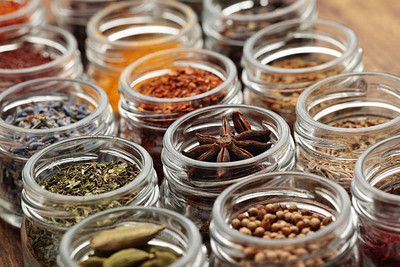Spices: where do they come from? where are they used?
Posted by The Wares Team on 24th Feb 2022
After the party and holiday season of Christmas and New Year, and the inevitable healthy eating season of January, February is a great month to make the most of cooking once again and to discover hearty, warm dishes that provide plenty of flavour, nourishment and that all-important comfort feel as we look to the end of winter!
Spices are the perfect addition to dishes from across the world and usually, it is the choice and blends of spices that will differentiate a dish or give it a regional feel. But what do you know about these wonderfully pungent and almost mystical kitchen essentials? Stock up on spice jars, fill them with delicious spices, and prepare to learn more about the wonderful array of spices on offer.
The mighty peppercorn
Peppercorns are perhaps the best known spice, and they have been recorded for culinary use as early as 4,000 years ago when pepper was recorded as a useful seasoning for Indian cuisine.
Spice blends
We may be used to spice blends such as Chinese five spice, named after the five flavours rather than certain ingredients, or Ethiopian Berbere, but the names of most of these ancient blends are unknown in origin. Take Chimichurri for example, from Argentina. Legend has it that Basque colonists originally named it tximitxurry, which translates loosely into 'a blend of many different spices, in no real order'.
Fermented garlic
Black fermented garlic, which is used in Korean cooking, is traditionally associated with immortality in Taoist mythology. Whether or not it will help you to live to 100, the ingredient does add a uniquely rich flavour to dips, eggs and meats, and it isn't remotely intense or harsh either, more reminiscent in fact of a savoury fig condiment.
Warming allspice
Allspice was named after Columbus bought pimento to Europe. The name caught on because the spice tasted like a blend of cinnamon, cloves and nutmeg, despite actually coming from a single dried berry. It's a wonderful ingredient for both baked desserts and many savoury dishes too, such as Jamaican jerk seasoning.
Stunning saffron
You might already know that saffron is one of the world's most expensive spices, but did you know that it is hand-harvested from the crocus sativus. Each flower contains just three to five stigmas that need to be gathered carefully and delicately without machinery. To produce a gram of saffron, a hundred flowers are needed. Luckily just a few strands are required to give any dish a gentle yellow hue and an intense flavour. Store this spice carefully in a glass spice jar away from light and heat to preserve it.
The dual-working tree
Nutmeg trees produce mace and nutmeg, the latter being the tree's seed and the former being the reddish, lacy covering that grows over the seed itself. Mace is the slightly more pungent of the two, although their flavours are quite similar. Nutmeg was once so hard to come by that the Dutch sold Manhattan island to the British in return for nutmeg-producing islands.
Know your masalas
Masala is often thought of as a seasoning, but the word is actually the English translation of spice. This means that a masala blend can be made of almost anything. Garam masala is earthy and warm, and chat masala is vibrant and tart for example. Stock up your spice jars with your masala blends and you'll have everything you need for Indian cooking.
Something unusual
You may not be familiar with annatto seeds or achiote seeds, but they are a great addition to your spice jars, as provide a slightly bitter peppermint scent and a gently peppery flavour. They are used to colour fabrics and cosmetics as well as to make Puerco pabil.
Climate counts
Bay laurel plants make two differently flavoured types of bay leaf because of the atmosphere and climate in which they grow. California Bay leaves are strong and have a hint of eucalyptus, and Turkish bay leaves are milder.
The rub
Do you know the difference between seasoning and a butcher's rub? It's all down the size of particles in your spice jar. A butcher's rub is coarse so that the seasoning will not burn during cooking. Seasoning works better for dishes cooked faster and at lower temperatures.
Stocking up on spice jars
A good spice jar will be made from glass and have an airtight seal, although this can be a cork, snap lid, rubber airtight seal or a screw-top lid. Glass is the ideal material for your jars as it won't stain or absorb flavours, and it can be sterilised and reused endlessly.
We have a wide range of very attractive spice jars on sale at Wares of Knutsford, with sizes, designs and finishes to suit all budgets. Nothing looks more beautiful or pleasing to a cook than a well-stocked spice rack or larder, so why not throw out your expired spices, take your new glass spice jars down to the zero waste shop and stock up!

